Listeria monocytogenes Interferes with Host Cell Mitosis through Its Virulence Factors InlC and ActA
Abstract
1. Introduction
2. Results
2.1. Lm Preferentially Infects Cells in G2/M-Phases of the Cell Cycle
2.2. Cellular Infection by Lm Increases the Duration of Host Cell Mitosis
2.3. Lm-Infected Cells Display a Delayed Mitotic Exit
2.4. Lm Infection Increases the Percentage of Misaligned Chromosomes
2.5. Lm Impairs Chromosome Alignement through ActA and InlC
3. Discussion
4. Materials and Methods
4.1. Bacterial Strains, Cell Lines and Growth Conditions
4.2. Construction of Deletion Mutants for InlC and Complemented Strains
4.3. Infection Assays
4.4. Flow Cytometry Procedures
4.5. Time-Lapse Microscopy
4.6. Immunoblot Analysis
4.7. Immunofluorescence
4.8. Fluorescence Microscopy and Image Analyses
4.9. Statistical Analyses
Supplementary Materials
Author Contributions
Funding
Acknowledgments
Conflicts of Interest
References
- European Food Safety Authority and European Centre for Disease Prevention and Control (EFSA and ECDC). The European Union One Health 2018 Zoonoses Report. EFSA J. 2019, 17, 5926. [Google Scholar] [CrossRef]
- Disson, O.; Lecuit, M. Targeting of the central nervous system by Listeria monocytogenes. Virulence 2012, 3, 213–221. [Google Scholar] [CrossRef] [PubMed]
- Lecuit, M. Human listeriosis and animal models. Microbes Infect. 2007, 9, 1216–1225. [Google Scholar] [CrossRef] [PubMed]
- Camejo, A.; Carvalho, F.; Reis, O.; Leitao, E.; Sousa, S.; Cabanes, D. The arsenal of virulence factors deployed by Listeria monocytogenes to promote its cell infection cycle. Virulence 2011, 2, 379–394. [Google Scholar] [CrossRef]
- Pizarro-Cerda, J.; Kuhbacher, A.; Cossart, P. Entry of Listeria monocytogenes in mammalian epithelial cells: An updated view. Cold Spring Harb. Perspect. Med. 2012, 2, a010009. [Google Scholar] [CrossRef]
- Radoshevich, L.; Cossart, P. Listeria monocytogenes: Towards a complete picture of its physiology and pathogenesis. Nat. Rev. Microbiol. 2018, 16, 32–46. [Google Scholar] [CrossRef]
- de Souza Santos, M.; Orth, K. Subversion of the cytoskeleton by intracellular bacteria: Lessons from Listeria, Salmonella and Vibrio. Cell. Microbiol. 2015, 17, 164–173. [Google Scholar] [CrossRef]
- Sousa, S.; Cabanes, D.; Bougneres, L.; Lecuit, M.; Sansonetti, P.; Tran-Van-Nhieu, G.; Cossart, P. Src, cortactin and Arp2/3 complex are required for E-cadherin-mediated internalization of Listeria into cells. Cell. Microbiol. 2007, 9, 2629–2643. [Google Scholar] [CrossRef]
- Cruz, R.; Pereira-Castro, I.; Almeida, M.T.; Moreira, A.; Cabanes, D.; Sousa, S. Epithelial Keratins Modulate cMet Expression and Signaling and Promote InlB-Mediated Listeria monocytogenes Infection of HeLa Cells. Front. Cell. Infect. Microbiol. 2018, 8, 146. [Google Scholar] [CrossRef]
- Costa, A.C.; Carvalho, F.; Cabanes, D.; Sousa, S. Stathmin recruits tubulin to Listeria monocytogenes-induced actin comets and promotes bacterial dissemination. Cell. Mol. Life Sci. 2019, 76, 961–975. [Google Scholar] [CrossRef]
- Gouin, E.; Quereda, J.J.; Cossart, P. Intracellular bacteria find the right motion. Cell 2015, 161, 199–200. [Google Scholar] [CrossRef] [PubMed][Green Version]
- Choe, J.E.; Welch, M.D. Actin-based motility of bacterial pathogens: Mechanistic diversity and its impact on virulence. Pathog. Dis. 2016, 74, ftw099. [Google Scholar] [CrossRef] [PubMed]
- Weddle, E.; Agaisse, H. Principles of intracellular bacterial pathogen spread from cell to cell. PLoS Pathog. 2018, 14, e1007380. [Google Scholar] [CrossRef]
- Ireton, K.; Rigano, L.A.; Polle, L.; Schubert, W.D. Molecular mechanism of protrusion formation during cell-to-cell spread of Listeria. Front. Cell. Infect. Microbiol. 2014, 4, 21. [Google Scholar] [CrossRef] [PubMed]
- Rajabian, T.; Gavicherla, B.; Heisig, M.; Muller-Altrock, S.; Goebel, W.; Gray-Owen, S.D.; Ireton, K. The bacterial virulence factor InlC perturbs apical cell junctions and promotes cell-to-cell spread of Listeria. Nat. Cell Biol. 2009, 11, 1212–1218. [Google Scholar] [CrossRef] [PubMed]
- Otani, T.; Ichii, T.; Aono, S.; Takeichi, M. Cdc42 GEF Tuba regulates the junctional configuration of simple epithelial cells. J. Cell Biol. 2006, 175, 135–146. [Google Scholar] [CrossRef]
- Leitao, E.; Costa, A.C.; Brito, C.; Costa, L.; Pombinho, R.; Cabanes, D.; Sousa, S. Listeria monocytogenes induces host DNA damage and delays the host cell cycle to promote infection. Cell Cycle 2014, 13, 928–940. [Google Scholar] [CrossRef]
- Hayward, D.; Alfonso-Perez, T.; Gruneberg, U. Orchestration of the spindle assembly checkpoint by CDK1-cyclin B1. FEBS Lett. 2019, 593, 2889–2907. [Google Scholar] [CrossRef]
- Maiato, H.; Gomes, A.M.; Sousa, F.; Barisic, M. Mechanisms of Chromosome Congression during Mitosis. Biology (Basel) 2017, 6, 13. [Google Scholar] [CrossRef]
- Lara-Gonzalez, P.; Westhorpe, F.G.; Taylor, S.S. The spindle assembly checkpoint. Curr. Biol. 2012, 22, R966–R980. [Google Scholar] [CrossRef]
- Kocks, C.; Gouin, E.; Tabouret, M.; Berche, P.; Ohayon, H.; Cossart, P.L. monocytogenes-induced actin assembly requires the actA gene product, a surface protein. Cell 1992, 68, 521–531. [Google Scholar] [CrossRef]
- Polle, L.; Rigano, L.A.; Julian, R.; Ireton, K.; Schubert, W.D. Structural details of human tuba recruitment by InlC of Listeria monocytogenes elucidate bacterial cell-cell spreading. Structure 2014, 22, 304–314. [Google Scholar] [CrossRef] [PubMed]
- Samba-Louaka, A.; Pereira, J.M.; Nahori, M.A.; Villiers, V.; Deriano, L.; Hamon, M.A.; Cossart, P. Listeria monocytogenes dampens the DNA damage response. PLoS Pathog. 2014, 10, e1004470. [Google Scholar] [CrossRef] [PubMed]
- El-Aouar Filho, R.A.; Nicolas, A.; De Paula Castro, T.L.; Deplanche, M.; De Carvalho Azevedo, V.A.; Goossens, P.L.; Taieb, F.; Lina, G.; Le Loir, Y.; Berkova, N. Heterogeneous Family of Cyclomodulins: Smart Weapons That Allow Bacteria to Hijack the Eukaryotic Cell Cycle and Promote Infections. Front. Cell. Infect. Microbiol. 2017, 7, 208. [Google Scholar] [CrossRef] [PubMed]
- Fan, Y.; Sanyal, S.; Bruzzone, R. Breaking Bad: How Viruses Subvert the Cell Cycle. Front. Cell. Infect. Microbiol. 2018, 8, 396. [Google Scholar] [CrossRef] [PubMed]
- Cai, L.; Tu, B.P. Driving the cell cycle through metabolism. Annu. Rev. Cell Dev. Biol. 2012, 28, 59–87. [Google Scholar] [CrossRef] [PubMed]
- Icard, P.; Fournel, L.; Wu, Z.; Alifano, M.; Lincet, H. Interconnection between Metabolism and Cell Cycle in Cancer. Trends Biochem. Sci. 2019, 44, 490–501. [Google Scholar] [CrossRef]
- Ueda, R.; Sugiura, T.; Kume, S.; Ichikawa, A.; Larsen, S.; Miyoshi, H.; Hiramatsu, H.; Nagatsuka, Y.; Arai, F.; Suzuki, Y.; et al. A novel single virus infection system reveals that influenza virus preferentially infects cells in g1 phase. PLoS ONE 2013, 8, e67011. [Google Scholar] [CrossRef][Green Version]
- Santos, A.J.; Meinecke, M.; Fessler, M.B.; Holden, D.W.; Boucrot, E. Preferential invasion of mitotic cells by Salmonella reveals that cell surface cholesterol is maximal during metaphase. J. Cell Sci. 2013, 126, 2990–2996. [Google Scholar] [CrossRef]
- Widmer, G.; Yang, Y.L.; Bonilla, R.; Tanriverdi, S.; Ciociola, K.M. Preferential infection of dividing cells by Cryptosporidium parvum. Parasitology 2006, 133, 131–138. [Google Scholar] [CrossRef]
- Thery, M.; Bornens, M. Cell shape and cell division. Curr. Opin. Cell Biol. 2006, 18, 648–657. [Google Scholar] [CrossRef] [PubMed]
- Thery, M.; Bornens, M. Get round and stiff for mitosis. HFSP J. 2008, 2, 65–71. [Google Scholar] [CrossRef]
- Lacayo, C.I.; Soneral, P.A.; Zhu, J.; Tsuchida, M.A.; Footer, M.J.; Soo, F.S.; Lu, Y.; Xia, Y.; Mogilner, A.; Theriot, J.A. Choosing orientation: Influence of cargo geometry and ActA polarization on actin comet tails. Mol. Biol. Cell 2012, 23, 614–629. [Google Scholar] [CrossRef] [PubMed]
- Lacayo, C.I.; Theriot, J.A. Listeria monocytogenes actin-based motility varies depending on subcellular location: A kinematic probe for cytoarchitecture. Mol. Biol. Cell 2004, 15, 2164–2175. [Google Scholar] [CrossRef] [PubMed][Green Version]
- Soo, F.S.; Theriot, J.A. Large-scale quantitative analysis of sources of variation in the actin polymerization-based movement of Listeria monocytogenes. Biophys. J. 2005, 89, 703–723. [Google Scholar] [CrossRef] [PubMed][Green Version]
- Ireton, K. Molecular mechanisms of cell-cell spread of intracellular bacterial pathogens. Open Biol. 2013, 3, 130079. [Google Scholar] [CrossRef]
- Chugh, P.; Paluch, E.K. The actin cortex at a glance. J. Cell Sci. 2018, 131, jcs186254. [Google Scholar] [CrossRef]
- Ramkumar, N.; Baum, B. Coupling changes in cell shape to chromosome segregation. Nat. Rev. Mol. Cell Biol. 2016, 17, 511–521. [Google Scholar] [CrossRef]
- Qin, Y.; Meisen, W.H.; Hao, Y.; Macara, I.G. Tuba, a Cdc42 GEF, is required for polarized spindle orientation during epithelial cyst formation. J. Cell Biol. 2010, 189, 661–669. [Google Scholar] [CrossRef]
- Arnaud, M.; Chastanet, A.; Debarbouille, M. New vector for efficient allelic replacement in naturally nontransformable, low-GC-content, gram-positive bacteria. Appl. Environ. Microbiol. 2004, 70, 6887–6891. [Google Scholar] [CrossRef]
- Pombinho, R.; Camejo, A.; Vieira, A.; Reis, O.; Carvalho, F.; Almeida, M.T.; Pinheiro, J.C.; Sousa, S.; Cabanes, D. Listeria monocytogenes CadC Regulates Cadmium Efflux and Fine-tunes Lipoprotein Localization to Escape the Host Immune Response and Promote Infection. J. Infect. Dis. 2017, 215, 1468–1479. [Google Scholar] [CrossRef]
- Monk, C.A.; Trafton, J.G.; Boehm-Davis, D.A. The effect of interruption duration and demand on resuming suspended goals. J. Exp. Psychol. Appl. 2008, 14, 299–313. [Google Scholar] [CrossRef] [PubMed]
- Edelstein, A.; Amodaj, N.; Hoover, K.; Vale, R.; Stuurman, N. Computer control of microscopes using microManager Current protocols in molecular biology. Chapter 2010, 14. [Google Scholar] [CrossRef]
- Schneider, C.A.; Rasband, W.S.; Eliceiri, K.W. NIH Image to ImageJ: 25 years of image analysis. Nat. Methods 2012, 9, 671–675. [Google Scholar] [CrossRef] [PubMed]
- Schindelin, J.; Arganda-Carreras, I.; Frise, E.; Kaynig, V.; Longair, M.; Pietzsch, T.; Preibisch, S.; Rueden, C.; Saalfeld, S.; Schmid, B.; et al. Fiji: An open-source platform for biological-image analysis. Nat. Methods 2012, 9, 676–682. [Google Scholar] [CrossRef] [PubMed]
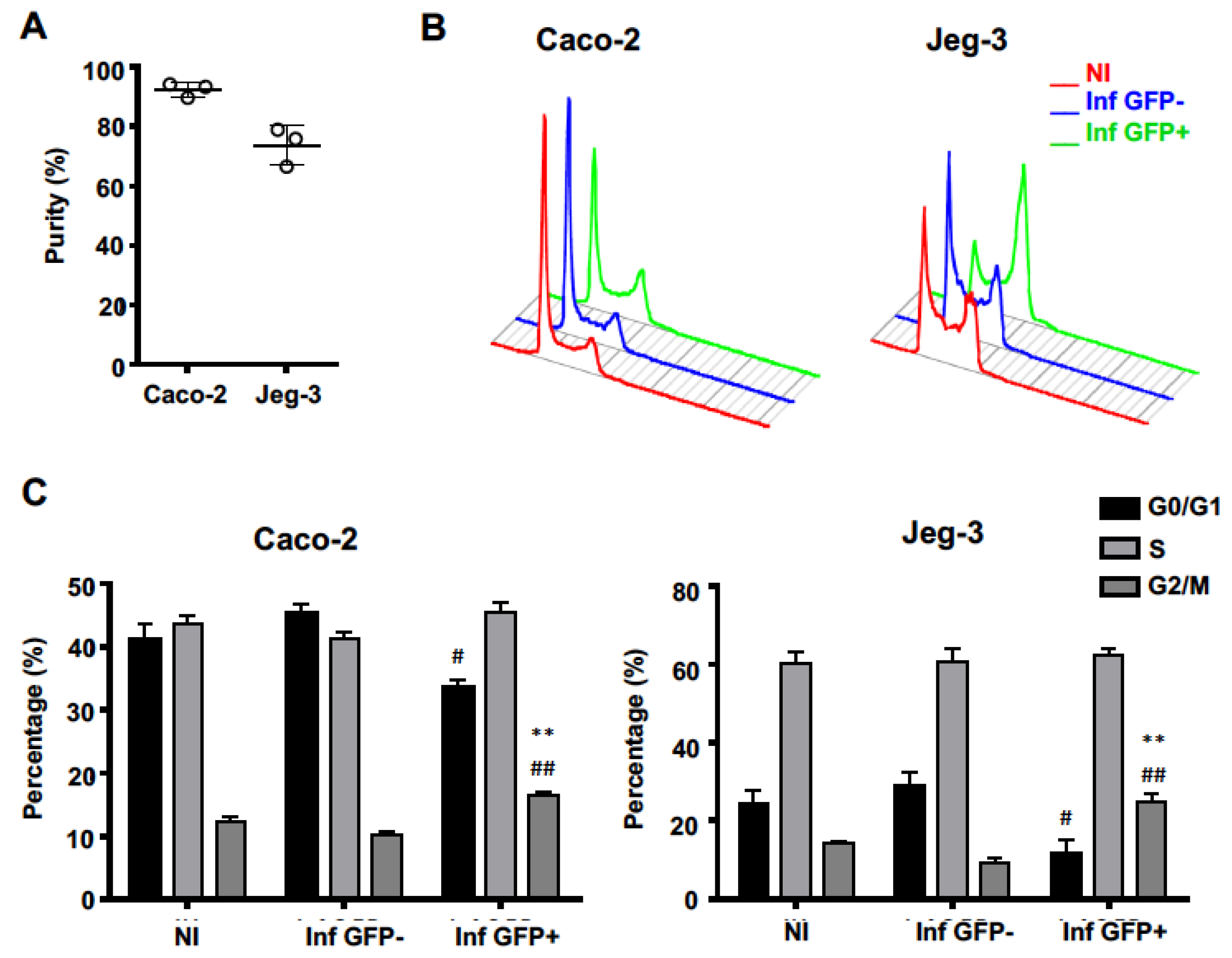
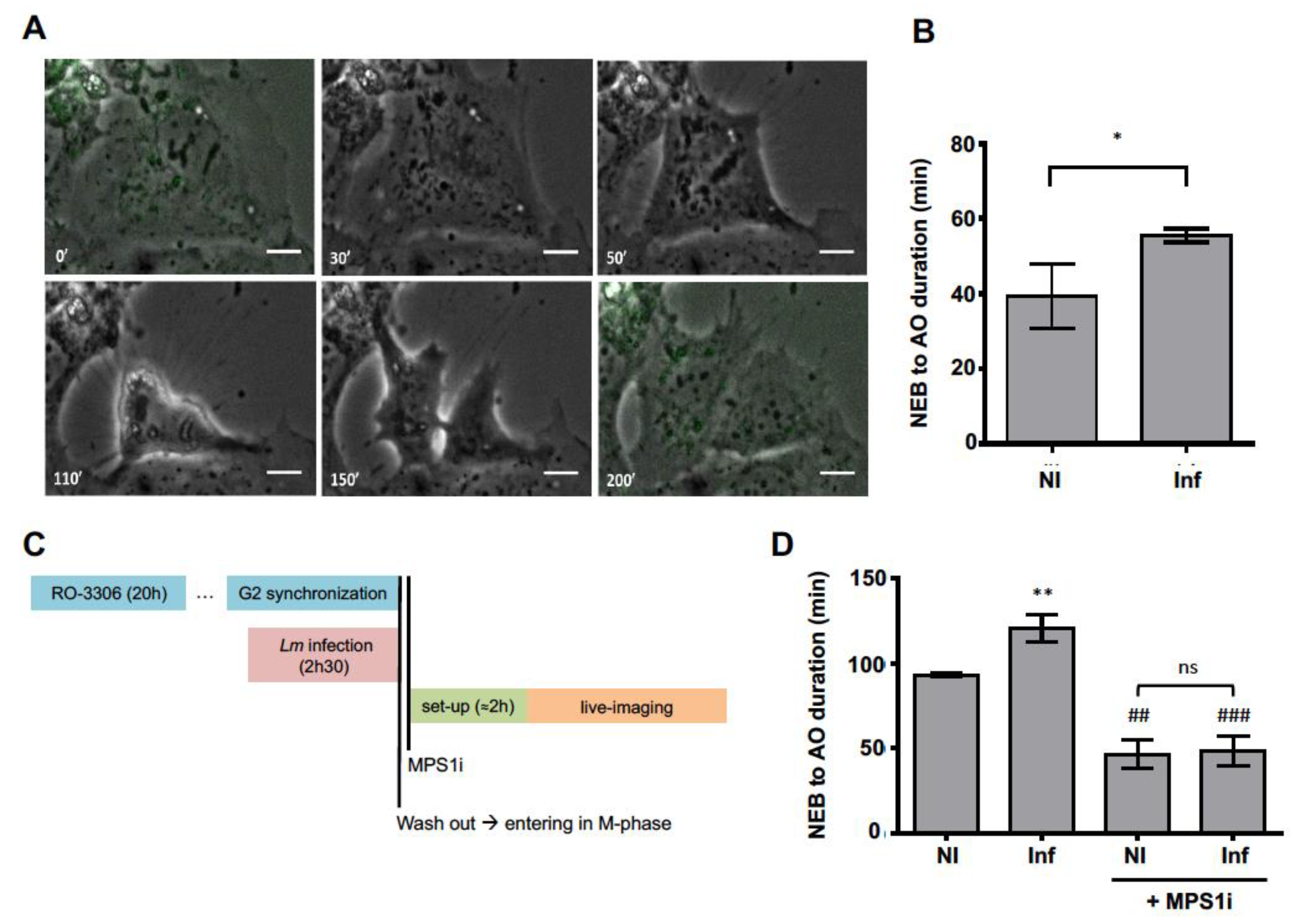
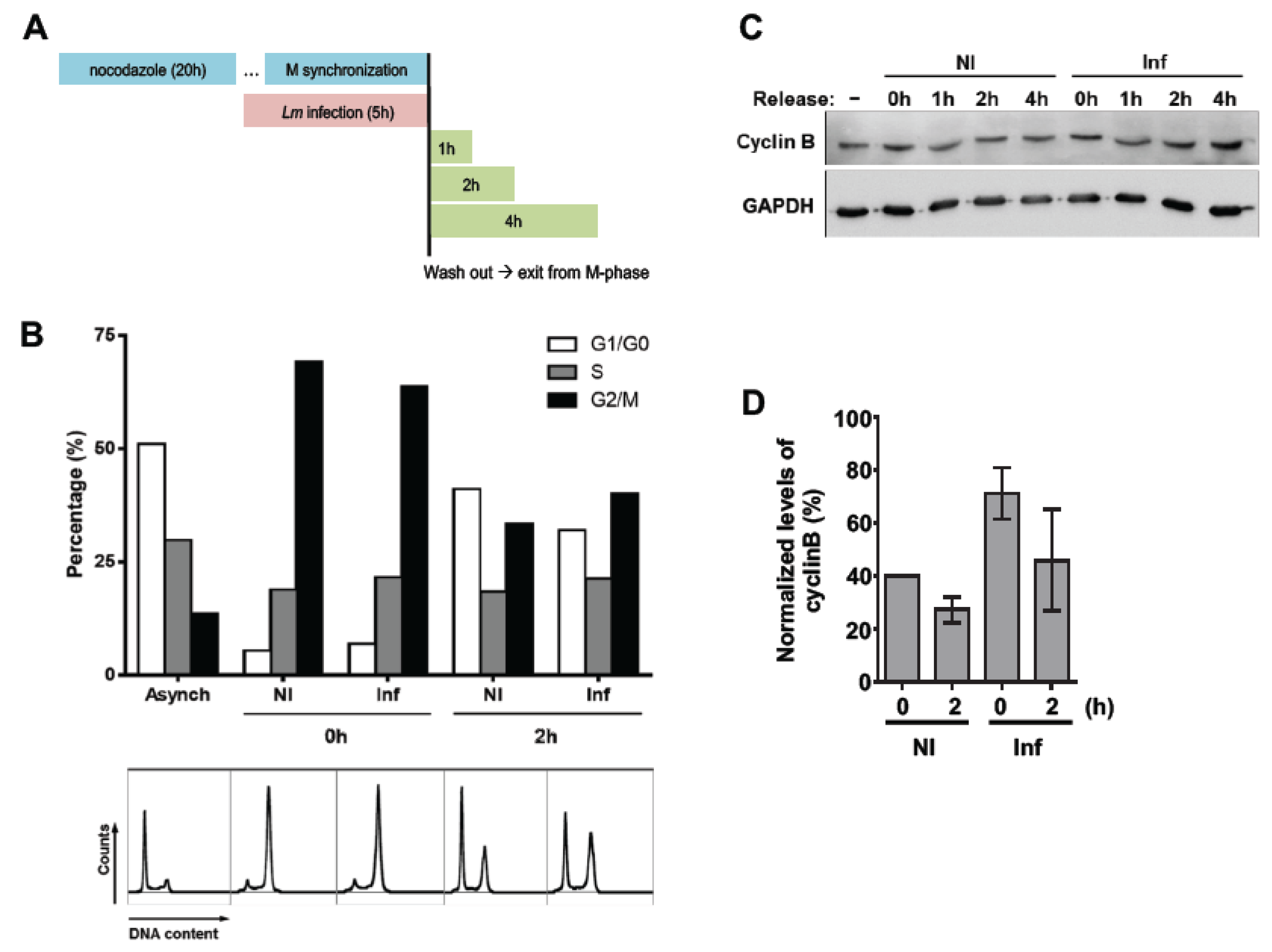
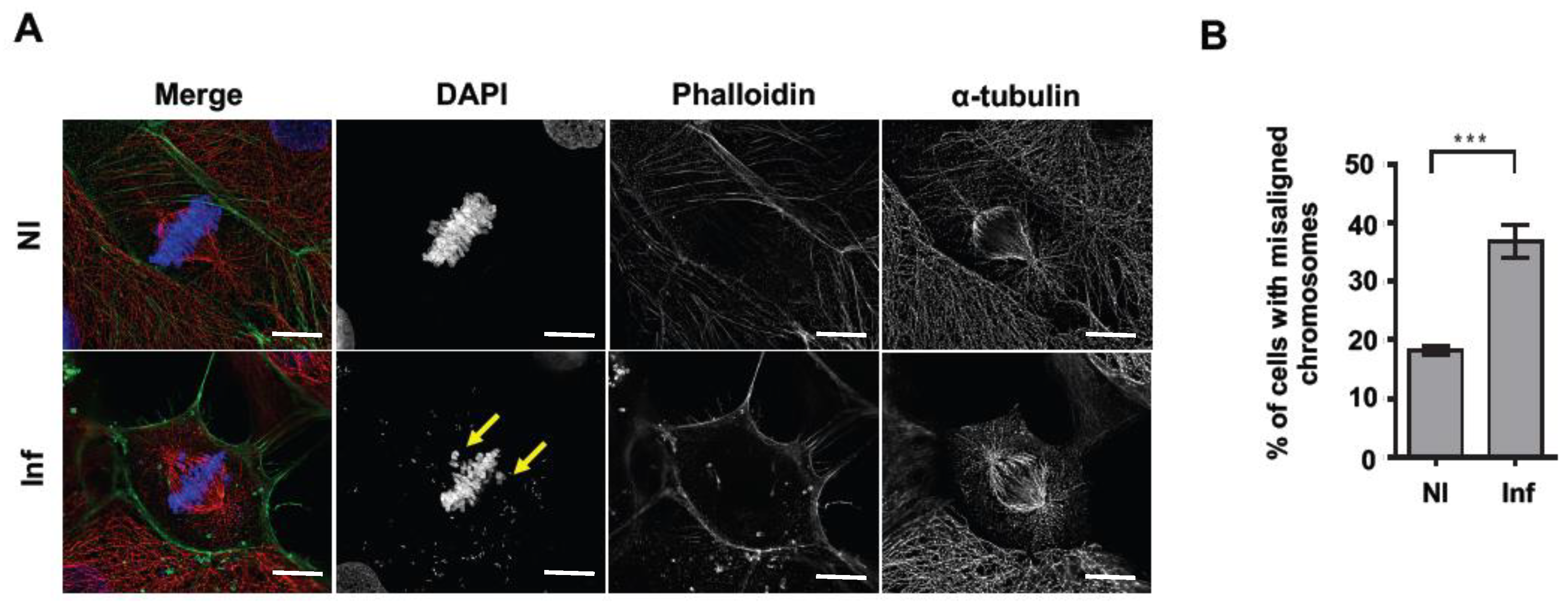
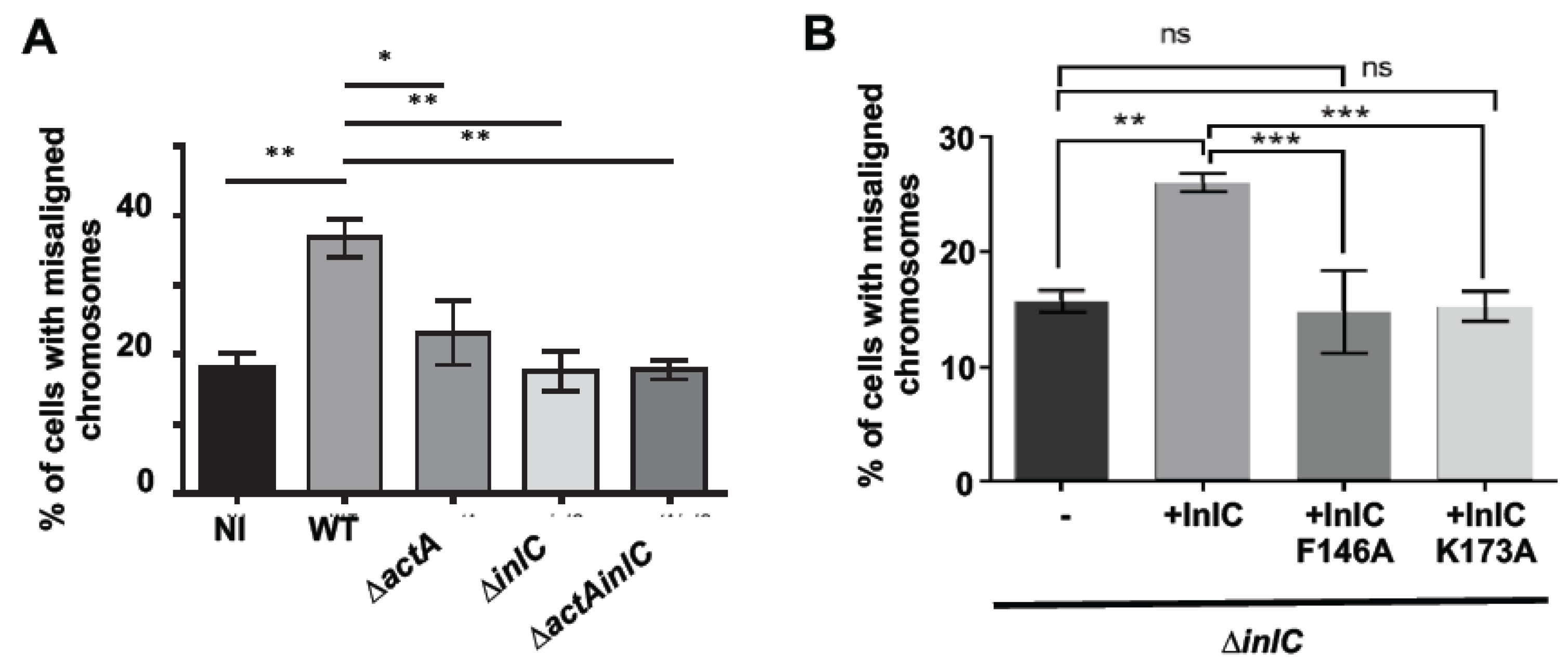
| Plasmid Generated | Primer Name | Primer Sequence (5′–3′) |
|---|---|---|
| pMAD (up+Dw) | # 1-Up Fwd | gcatgGTCGACggcatagaaagtagattcc |
| # 2-Up Rev | agatcACGCGTcaacattctccactcctt | |
| # 3-Dw Fwd | cattACGCGTtaggacttgtgcacacctg | |
| # 4-Dw Rev | cctgAGATCTgaagtcatgttcgtcaatcg | |
| pIMK (inlC WT) | # 5-inlC Fwd | actCCATGGcaaaaaaaaataattggttacaa |
| # 6-inlC Rev | taaGGTACCctaatgatgatgatgatgatgattcttgataggttgtgtaac | |
| pIMK (inlC F146A) | # 7-F146A Fwd | gtttatctcgcttggctttagataacaacg |
| # 8-F146A Rev | cgttgttatctaaagccaagcgagataaac | |
| pIMK (inlC K173A) | # 9-K173A Fwd | cttatctattcgtaataatgcgttaaaaagtattgtgatg |
| # 10-K173A Rev | catcacaatactttttaacgcattattacgaatagataag |
© 2020 by the authors. Licensee MDPI, Basel, Switzerland. This article is an open access article distributed under the terms and conditions of the Creative Commons Attribution (CC BY) license (http://creativecommons.org/licenses/by/4.0/).
Share and Cite
Costa, A.C.; Pinheiro, J.; Reis, S.A.; Cabanes, D.; Sousa, S. Listeria monocytogenes Interferes with Host Cell Mitosis through Its Virulence Factors InlC and ActA. Toxins 2020, 12, 411. https://doi.org/10.3390/toxins12060411
Costa AC, Pinheiro J, Reis SA, Cabanes D, Sousa S. Listeria monocytogenes Interferes with Host Cell Mitosis through Its Virulence Factors InlC and ActA. Toxins. 2020; 12(6):411. https://doi.org/10.3390/toxins12060411
Chicago/Turabian StyleCosta, Ana Catarina, Jorge Pinheiro, Sandra A. Reis, Didier Cabanes, and Sandra Sousa. 2020. "Listeria monocytogenes Interferes with Host Cell Mitosis through Its Virulence Factors InlC and ActA" Toxins 12, no. 6: 411. https://doi.org/10.3390/toxins12060411
APA StyleCosta, A. C., Pinheiro, J., Reis, S. A., Cabanes, D., & Sousa, S. (2020). Listeria monocytogenes Interferes with Host Cell Mitosis through Its Virulence Factors InlC and ActA. Toxins, 12(6), 411. https://doi.org/10.3390/toxins12060411






